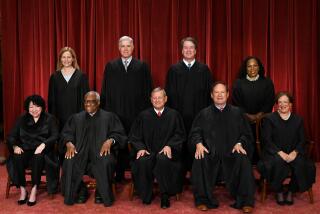Surprising, Perhaps, but a Strong Choice : Last week, court nominee seemed to be below others on list two other nominees seemed to be at top of list
- Share via
It should come as no surprise that President Clinton, who campaigned as a centrist, has picked for the U.S. Supreme Court a judge who has a reputation for consensus-building and centrist views. Nonetheless, Clinton’s nomination Monday of Judge Ruth Bader Ginsburg--who was named after it was widely assumed that one of two other candidates would be tapped--took many court-watchers by surprise. Surprise or not, Ginsburg appears to be a solid choice for a President sorely in need of a confirmable candidate, and for a divided court in search of a center that will hold.
Ginsburg, 60, a Washington, D.C., federal appeals court judge, would replace retiring Justice Byron R. White, who 88 days ago announced his resignation, which will take effect when the court’s term ends this month. The nomination came after weeks of White House leaks and trial balloons. Such is the bread and butter of Washington politics for both parties, but the search for White’s replacement unfortunately generated more than the usual flak as Administration staffers strongly implied that the nomination of one serious candidate after another was all but a done deal. For at least two of those candidates, Interior Secretary Bruce Babbitt and Judge Stephen G. Breyer of the federal appeals court in Boston, that process was no doubt embarrassing if not downright humiliating.
Ginsburg’s candidacy grew stronger late last week after concern arose that Babbitt was too valuable to lose at Interior and a whiff of the “Nannygate” problem tainted Breyer’s nomination, as it had those of others for top Administration posts. But Ginsburg, a leading figure in the federal judiciary since her appointment in 1980 by President Jimmy Carter, is hardly a third-rate nominee. Given the highest rating of the American Bar Assn., she is distinguished by the breadth of her legal experience on and off the bench. Before joining the appeals court, she was best known as a lawyer for women’s rights, arguing several early sexual-bias cases before the Supreme Court and winning all but one.
As a judge, she seems to have moved toward the center, drawing criticism from former allies for some of her rulings and for comments off the bench. In a speech last March, for example, she said that the landmark Roe-vs.-Wade decision, guaranteeing abortion rights, halted “a political process that was moving in a reform direction and thereby, I believe, prolonged divisiveness and deferred stable settlement of that issue.”
However, Ginsburg must remember that her job on the high court would be not just to define the middle but to use what Clinton called her “heart and spirit” to lead her colleagues and the American people toward justice in all issues.
Ginsburg would become the second woman ever on the Supreme Court. Her appointment is not mere tokenism. Justice Sandra Day O’Connor’s discussion of the unique burdens that childbearing places on women, in her majority opinion last year in the controversial Pennsylvania abortion case, demonstrated that gender, like race, in fact helps shape the concept of justice and fairness.
Clinton appears to have chosen wisely for the Supreme Court. But about 125 empty seats remain on federal district and appellate courts nationwide. Filling this enormous--and steadily growing--number of judicial vacancies must now command the President’s immediate attention.
More to Read
Get the L.A. Times Politics newsletter
Deeply reported insights into legislation, politics and policy from Sacramento, Washington and beyond. In your inbox twice per week.
You may occasionally receive promotional content from the Los Angeles Times.










